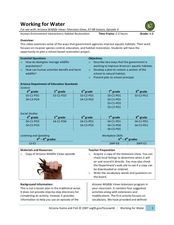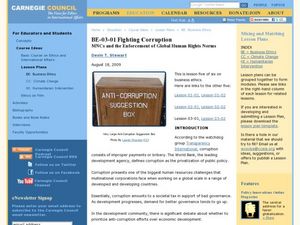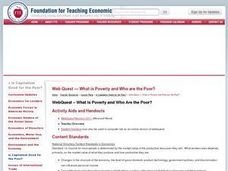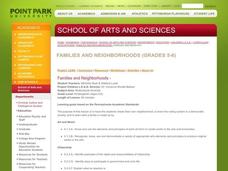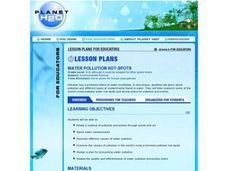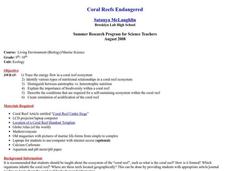Curated OER
Working for Water
Students examine the ways that government works to help improve aquatic habitats. In this water habitats lesson students view a video and plan a school restoration project.
Curated OER
Violence on TV and Our Response
Students examine violence on television. In this media awareness lesson, students discuss the types of fictional and realistic violence shown on American television. Students participate in a Congressional simulation activity on the...
Curated OER
Shopping for Souvenirs In the Middle East
Students participate in a role play in which they are shopping for souvenirs in the Middle East. Using maps, they locate the Middle East and identify each country within the region. They create a key map for the types of souvenirs that...
Curated OER
Fibers and Fabric
Students are introduced to a variety of different fibers. After acting out a short story, they discover how yarn and basic weaves are made. To end the lesson, they practice making their own weave pattern using paper strips and then yarn.
Curated OER
Milk and Dairy, Day 1
Students review different types of milk products and their characteristics, demonstrate how to select and prepare milk and milk products, identify standard serving sizes, define terms associated with milk and milk products, and practice...
Curated OER
Hey, Mom! What's for Breakfast?
Students examine how he world eats breakfast. In this food choices lesson, students work in groups to list breakfast foods and their ingredients and find goods and consumers on the list. The, students use the Internet to complete a...
Curated OER
The Unseen Army: Conscientious Objectors During World War II
Learners study World War II and why it was called "the Good War". In this World War II activity learners identify the different kinds of conscientious objectors.
Curated OER
Fighting Corruption
Twelfth graders research the different types of business ethics. In this Economics lesson, 12th graders read various handouts on corruption. Students participate in a discussion on trying to end corruption.
Curated OER
Classifying Monocot And Dicot Plants
Sixth graders identify the parts of a flower, and tell the difference between monocots and dicots. They group plant by leaf types and characteristics placing the information in table form on the computer.
Curated OER
WebQuest- What is Poverty and Who Are the Poor?
Students are introduced to a variety of easily accessible data about poverty. The search activity performs double-duty in exposing students to the nature and magnitude of world poverty and in confronting them with different types and...
Curated OER
Science: Create Your Own Rock
Second graders create rocks using colored paper to represent the various minerals. After reviewing the various minerals contained in rock, they cut pieces of scrap paper and paste them on handouts. Finally, 2nd graders give their rocks...
Curated OER
Transportation
In this transportation worksheet, students list the positive and negative aspects of different types of transportation. Students keep a diary of the different ways they used transportation for a week. This worksheet has 7 graphic...
Curated OER
Urban and Rural Communities
Students discuss similarities and differences of urban and rural communities. For this urban and rural communities lesson, students compare urban and rural communities using a Venn Diagram. Students examine maps of each type of...
Curated OER
Deciphering Community
Young scholars explore the concept of a community. They identify and group various kinds of communities. Students create a concept map exemplifying their membership in different communities. They write a narrative describing their...
Curated OER
Eastern Woodland Indians
Fifth graders research the Eastern Woodland Indians in this lesson. They list the tribes and write a description of the physical environment. They list examples of the types of food, clothing, transportation, home/shelter,...
Curated OER
Families and Neighborhoods
Students build their own neighborhood. In this instructional activity on community, students are introduced to books about families and neighborhoods. As a class, the students create their own neighborhood, elect a leader for their...
Curated OER
The General Grammar Quiz
In this verb tense and sentence writing learning exercise, students must determine wlhat tense a verb is written in; what type of sentences are given along with the number of clauses. Students rewrite sentences and complete sentences to...
Curated OER
Flowing Electrons
Students act out different types of circuits, and create their own circuits using wire, a bulb, a battery and a switch.
Curated OER
Water Pollution Hot-Spots
Students complete internet research in small groups to identify types of water pollution, spotlight water pollution hot-spots, and design a plan for water prevention.
Curated OER
Angle Land and Angle Aerobics
Sixth graders investigate different types of angles. In this geometry instructional activity, 6th graders use a protractor to identify acute, obtuse, and straight angles.
Alabama Learning Exchange
Our World is Like a Rainbow
Young scholars create a Venn diagram of people's similarities and differences. They investigate why people relocate to different geographic regions after investigating the positives and negatives of different states.
Curated OER
Coral Reefs Endangered
Learners identify different types of nutritional relationships in a coral reef system and trace the energy flow. In this marine biology lesson students create a simulation of acidification of the coral reef.
Curated OER
Rock Hounds at Heart
Second graders read "Sylvester and the Magic Pebble" by iam Steig and practice describing rocks using different physical properties. They make observations and develop and describe categories such as texture, color, density, hardness, etc.
Curated OER
Family Life Cycle
Learners review the food groups and their placement on the food pyramid. Using the internet, they research the nutritional guidelines for different age groups and compare them. To end the lesson, they identify reasons for choosing the...


